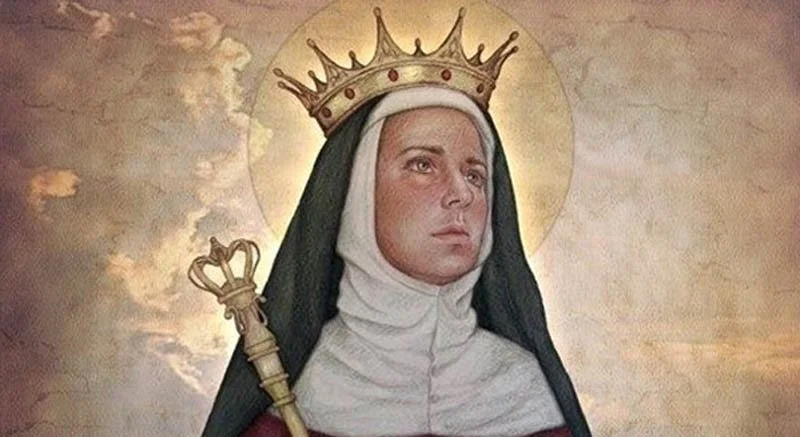Saint Mechtilde (Matilda) of Hackeborn (1241-1298) and Saint Gertrude the Great (1256-1302)
St. Mechtilde, courtesy of St. Mary of Mount Carmel / Blessed Sacrament Parish
St. Gertrude, courtesy of Catholic online
By D’Wayne Hodgin
Two for the price of one this week, and it could have been four.
In the mid- to late-1200s, the Convent at Helfta (Germany) had four of the most influential mystic theologians, "the glory of German monasticism" (ewtn.com/catholicism/library). All four were there together for at least a few years in the 1280s–two were named Gertrude and two, Mechtilde. Though they all seemed to help each other grow in spirituality, the two most prominent were Mechtilde of Hackeborn and Gertrude the Great.
Those attending Mechtilde at her birth considered her so fragile that they took her to a priest so that he could baptize her before she died. After baptizing her, he admonished the attendants, "What do your fear? This child most certainly will not die, but she will become saintly religious in whom God will work many wonders, and she will end her days in good old age" (Wikipedia).
As a seven-year-old, she and her parents visited Mechtilde's older sister, Gertrude, a nun at the Cistercian monastery in Rodersdorf. Mechtilde became so enraptured with the convent that she persuaded her parents to let her become a novitiate.
Ten years later, she moved with her sister, who had become abbess, to a monastery on an estate in Helfta. Mechtilde was known for her fervor, her humility, and her friendliness. But she was best known for her beautiful singing voice and her fervent spirituality, even in the face of severe suffering over the last eight years of her life. In 1261, the abbess commissioned her to be in charge of a five-year-old girl who had been brought to the abbey either as an oblate ("one offered up," as was Samuel in 1 Samuel 1: 24-27) or as an orphan. The little girl was named Gertrude and later would be called Gertrude the Great.
Mechtilde tutored and trained the girl in the ways of a nun. They became close, almost like mother-daughter. Mechtilde continued in her role as choir director of the abbey and confident for any who came to her with problems. When Mechtilde was fifty, she discovered that Gertrude and a few other nuns were writing down practically everything that Mechtilde said. She had been writing her prayers and her visions down in what she considered to be the beginning of a book of spirituality, and she felt betrayed, offended by the actions of Gertrude and the other few nuns. She had a vision of Christ holding in His hand the book of her revelations; He said, "All this has been committed to writing by my will and inspiration; therefore, you have no cause to be troubled about it" (newadvent.org). He also told her to call the writings, The Book of Special Grace. She then went on to edit what the other nuns had written. After she died, the book was published and garnered great popularity throughout Europe. There is plausible evidence of similitude between the real life Mechtilde and Dante's Donna Matilda in The Purgatorio, written about fifty years after publication of The Book of Special Grace.
Gertrude, an extremely bright child, learned all that Mechtilde could teach her, especially the classic writers. But in 1281, when she was 25 years old, Gertrude experienced the first of a series of visions that she experienced throughout the rest of her life. In her first vision, Jesus told her to move from studying the classics to studying scripture and theology. An enthusiastic student, she spent the rest of her life writing for the spiritual benefit and welfare of others.
In one vision, during the Feast of John the Evangelist, she saw herself resting her head near Jesus' wound in His side. She could hear the beating of His heart. She asked John if on the night of the last supper, if he heard the beating of Jesus' heart, why didn't he write about it. John responded by saying that this revelation had had been reserved until the world needed to rekindle its love for the heart of Jesus. And that time had come. Gertrude wrote the book, Herald of Divine Love, in which she describes her visions of Christ's heart of love. She believed that out of the wound in His side, Jesus' heart poured out a redeeming fountain, an image that already existed, especially in Bernard of Clairvaux commentary on the Song of Solomon.
After her death, Gertrude's writings all but disappeared. With the invention of the printing press, her writings spread throughout Europe, with editions in Latin, Italian, and German. In later centuries, her works became popular in Spain and France and eventually the English-speaking world.
As an oblate, Gertrude was never solemnly canonized, but a liturgical office of prayer, readings, and hymns in her honor was authorized by Rome, in 1606, considered a canonization. Around 1738, Pope Benedict XIV gave Gertrude the title, "Great," to distinguish her from Mechtilde's sister, the abbess of Helfta, and from other Gertrudes in the Catholic Church. This Gertrude is the only female in the list of saints with the title, "Great." You can visit Saint Gertrude's Monastery near Cottonwood, Idaho, to learn more about this famous sister of God.
Mechtilde and Gertrude share a Feast Day in the Episcopal Church Calendar of November 21.
Sources: catholic.org/saints; coraevans.com/blog/article7; ewtn.com/catholicism/library; newadvent.org; wikipedia


